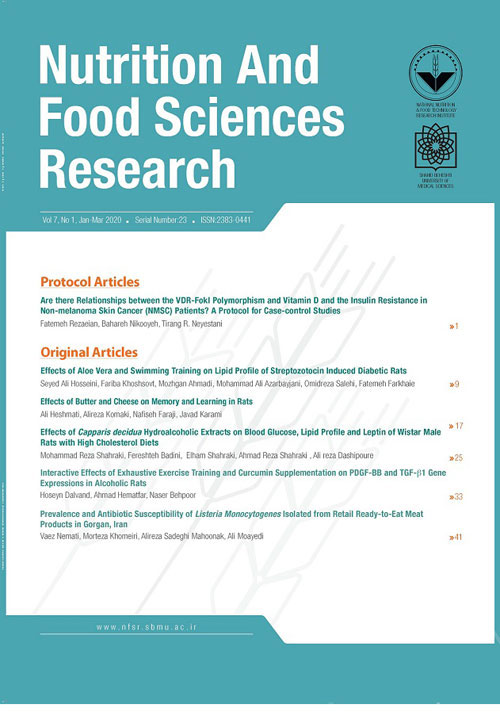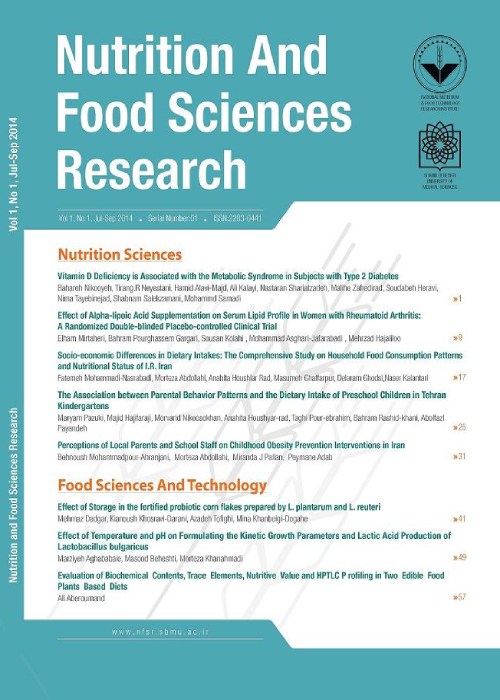فهرست مطالب

Nutrition & Food Technology Research
Volume:7 Issue: 3, Jul Sep 2020
- تاریخ انتشار: 1399/05/22
- تعداد عناوین: 6
-
-
Pages 1-7Background and Objectives
Dietary total antioxidant capacity (DTAC) is suggested as a useful tool for the assessment of relationships between cumulative antioxidant food capacities and several chronic disorders. However, relationships between the total antioxidant capacity of the diet (TAC) and the risk of NAFLD has not previously been assessed. The aim of this study was to assess relationships between DTAC and risk of NAFLD in a case-control study.
Materials and MethodsThis case-control study was carried out on 158 patients with NAFLD and 357 healthy individuals aged 18–55 years. Dietary data were collected using validated 168- items quantitative food frequency questionnaires. Triglyceride (TG), total cholesterol (TC), high density lipoprotein (HDL-C), low density lipoprotein (LDL-C) and fasting blood glucose (FBS) concentrations were assessed using enzymatic methods and commercial kits. The DTAC was calculated based on the oxygen radical absorbance capacity of each food (except for coffee) reported by US Department of Agriculture. Statistical Analysis was carried out using SPSS Software.
ResultsThe mean±SD (standard deviation) for age and body mass index (BMI) of the study participants were 43.9 years ±5.9 and had 30.5 kg/m2 ±2.6. The NAFLD patients included higher BMI and female proportion, compared to control group. The NAFLD patients included higher smoking rates, biochemical parameters (TG, TC, HDL-C, LDL-C and FBS) and DTAC scores, compared to control groups. However, patients with NAFLD included lower HDL levels and physical activities, compared to control group. The highest tertile of DTAC showed lower risks of NAFLD, compared to the lowest tertile. This association was significant after controlling for potential confounders (p for trend <0.001).
ConclusionsFindings suggest that promotion of naturally increased antioxidant capacities may help prevent development of NAFLD.
Keywords: Dietary total antioxidant capacity, Obesity, Nonalcoholic fatty liver disease -
Pages 9-14Background and Objectives
Adequate nutrition is closely linked to clinical outcomes. Therefore, this study was carried out to assess nutritional statuses of the ICU patients in Isfahan, Iran.
Materials and MethodsIn this cross-sectional study, 55 critically ill adult patients receiving enteral nutrition for a minimum of seven days were participated. Nutritional screening, including acute physiology and chronic health evaluation (APACHE) score, nutrition risk in critically (NUTRIC) score and nutritional assessments of laboratory data, energy and protein balance, was carried out. Moreover, gastrointestinal problems was assessed.
ResultsIn total, 55 patients (35 men and 20 women) with the median [IQR] age of 49 [18–77] years and the median [IQR] weight of 75 (55–100) kg were included in this study. The average of albumin concentrations were 3 g/dl ±0.7 in ICU inpatients, indicating decreased albumin levels compared to normal ranges (3.5–5 g/dl). During inpatient period, nutrition screening showed a median range of NUTRIC score of 3 (2–5) and APACHE score of 23 (18–27). In addition, median range of weight decreased to 71 (50–96) kg. Median intakes of energy and proteins for seven days seemed inadequate (1920 [1200–2740] and 86 [49–129], respectively). After gastrointestinal assessment, 20% of the participants had nausea and vomiting, 10% had obstipation, 5% had diarrhea and 20% had enteral feeding intolerance (assessed by GRV > 250 mL at repeated regular (6 h) measurements).
ConclusionsResults have suggested that although imbalanced energy, insufficient protein intakes, and gastrointestinal complications are common in ICU patients especially in women, risk assessment of malnutrition has shown no critical results. Therefore, designing and providing more sensitive methods for the screening of nutrition and assessment of nutritional adequacy is essential to prevent malnutrition in societies.
Keywords: Intensive care unit, Malnutrition, Nutrition assessment, Gastrointestinal complication -
Pages 15-23Background and Objectives
This study was carried out to assess food habits and their associations with weight status and metabolic risk factors in adults in Tehran, Capital of Iran.
Materials and MethodsA cross-sectional survey was conducted in a sample of adults (n=227) over 18 years old residing in Tehran. Demographic, anthropometric and food frequency questionnaires were filled out for all of the participants. Food habits were recorded using dietary habit questionnaires. Serum concentrations of glucose and lipids (total cholesterol [TC], triglycerides [TG] and high-density lipoprotein-cholesterol [HDL-C]) were analyzed from fasting blood samples.
ResultsThe mean body mass index (BMI) was 28.52 kg/m2 and a minority of the participants (22.2%) had normal BMI. The participants rarely used table salt, fast food and crispy foods, dined at restaurants and had two snacks, three or more meals a day, five or more breakfast episodes a week and regular meals. They used vegetable oils for cooking and frying and/or cooking oil for frying. Drivers (p < 0.001) and less educated participants (p= 0.012) were susceptible to overweight. Positive associations were found between the BMI and the participant age (rs =0.28, p<0.001) and serum glucose (rs = 0.22, p =0.005), TG (rs = 0.34, p< 0.001) and TC (rs = 0.36, p < 0.001). Participants with normal weights had regular meals
(p= 0.034) and frequent snacks (p = 0.048). Overweight and obese participants had a higher rate of dyslipidemia (serum TG ≥ 150 mg/dL), compared to that of the normal weight participants (18.0 and 35.0% vs.7.9%, p=0.004).ConclusionsThe present participants had relatively healthy food habits, except for the order of meals and saturated fat consumptions. This study confirms the associations between overweight/obesity and dyslipidemia. Nutrition education with emphases on regular meals and frequent snacks (as protective habits against obesity) is recommended, especially for susceptible groups.
Keywords: Food habits, Adults, Metabolic risk factors, Overweight -
Pages 25-32Background and Objectives
A strong link between child malnutrition and poverty has been documented especially in developing countries. Considering one child under two year out of three in Rwanda suffers from some form of malnutrition, promoting community welfare seems to bring about beneficial outcomes in terms of reduction of malnutrition. This study aims to determine and estimate the risk factors associated with deprivation and infant malnutrition in Rwanda.
Materials and MethodsThe methodology targeted mostly households with children under two years. Using two consecutive nationally representative population-based survey data of Rwanda, Demographic and Health Survey 2010/11 and 2014/15, the risk factors associated with the outcome were determined and using stepwise logistic regression analysis, the socioeconomic determinants were predicted.
ResultsThe findings were estimated from a sample of children under two years: 3,441 and 2,975 in Rwanda Demographic and Health Surveys 2010 and 2014/15. Households in the lowest wealth quintile were more likely to have children experiencing malnutrition (OR= 1.61, 95% CI: 1.17-2.2, p < 0.05 in 2010/11; OR= 1.7, 95% CI: 1.23-2.35, p<0.01 in 2014/15) whereas deprivation was less likely to associate with malnutrition among children under two years (OR=0.53, 95% CI: 0.35-0.8, p < 0.001 in 2014/15). Overall, the trend went down significantly with the slope of 0.1536 suggesting a decrease of deprivation between two surveys by 0.065.
ConclusionsWith the assumption of constancy of other factors, the trend of deprivation was significant to explain its association with infant malnutrition. Therefore, strengthening social protection interventions targeting the lowest wealth quintile category to afford food against price volatility are highly suggested.
Keywords: Dual burden, Food security, Deprivation, Stunting, Wasting, Underweight -
Pages 33-40Background and Objectives
Drying affects quality parameters of the grains. The objective of this study was to investigate effects of drying methods, moisture contents at harvesting time and corn hybrids on mechanical properties (deformation, rupture force, firmness, necessary energy and power and toughness at rupture points) and electrical conductivity of corn kernels.
Materials and MethodsThe study assessed four corn hybrids (Ns640, Jeta600, Konsur580 and SC704) harvested at various moisture contents (20, 30 and 40%) and dried using two drying methods (sun dried and artificially dried using oven at 85–90 oC).
ResultsResults revealed that corn variety significantly affected mechanical properties since Ns640 included the maximum and Konsur580 the minimum properties, compared to that other hybrids did. Furthermore, variety affected electrical conductivity. Konsur580 variety exhibited a higher electrical conductivity in both drying methods. Moisture contents at harvesting time significantly affected all mechanical properties, except deformation and firmness, in the two drying methods. Higher values of mechanical properties were achieved at 20% moisture. Moreover, effects of the moisture contents on electrical conductivity were significant and kernels with 40% moisture at harvesting time included higher electrical conductivities.
ConclusionsDrying methods of corn significantly affected quality parameters and electrical conductivity. Corn kernels dried in sun included higher levels of properties such as rupture force, necessary energy and power, toughness and lower levels of electrical conductivity.and kernels with 40% moisture at the time of harvest had higher electrical conductivity. The drying method of corn significantly influenced the mechanical properties and electrical conductivity. Corn kernels dried in sun had higher levels of properties including rupture force, the energy required, the power required, toughness and lower level of electrical, conductivity.
Keywords: Maize, Drying method, Harvesting time, Mechanical properties, Electrical conductivity -
Pages 41-48Background and Objectives
Increased frozen food consumptions have led to increased demands for gums with unique properties. Gums are used for the stabilization of food products that undergo various processing. Due to increases in gum use in food industries and high prices of commercial gums, use of native gums has been considered important recently. Therefore, the aim of this study was to assess effects of freezing treatments on textural characteristics of Lepidium perfoliatum seed and xanthan gums at various concentrations.
Materials and MethodsEffects of freezing process at -18 ºC for 24 h were investigated on textural characteristics of Lepidium perfoliatum seed gum at various concentrations of 0.50, 1.00, 1.50 and 2.00% )w/w) and results were compared with those a commercial xanthan gum.
ResultsResults showed that hardness, stickiness, consistency and adhesiveness increased significantly by increasing the concentration of gums from 0.50 to 2% (p > 0.05). Values of the textural parameters were higher in xanthan gum than Lepidium perfoliatum seed gum. Freezing process at low concentrations of gums led to significant increases in textural parameters (p < 0.05). However, textural parameters of gums at higher concentrations decreased after freezing treatments. Xanthan gum included a greater L* value than that Lepidium perfoliatum seed gum did. Therefore, appearance of xanthan gum was brighter than appearance of Lepidium perfoliatum seed gum. Furthermore, freezing process did not include significant effects on a* and b* values of gums.
ConclusionsDue to the high similarity of Lepidium perfoliatum seed gum with xanthan gum in terms of stability (high stability), the former gum can be considered as an appropriate stabilizing agent under freezing conditions. These findings suggest that Lepidium perfoliatum seed gum, as a stabilizer, can be used in formulation of frozen foods to provide specific functionality, minimize negative effects of freezing and decrease production costs
Keywords: Lepidium perfoliatum seed gum, Freezing, Stabilizing agent, Xanthan gum


